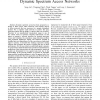Free Online Productivity Tools
i2Speak
i2Symbol
i2OCR
iTex2Img
iWeb2Print
iWeb2Shot
i2Type
iPdf2Split
iPdf2Merge
i2Bopomofo
i2Arabic
i2Style
i2Image
i2PDF
iLatex2Rtf
Sci2ools
INFOCOM
2009
IEEE
2009
IEEE
ALDO: An Anomaly Detection Framework for Dynamic Spectrum Access Networks
—Dynamic spectrum access has been proposed as a means to share scarce radio resources, and requires devices to follow protocols that use resources in a proper, disciplined manner. For a cognitive radio network to achieve this goal, spectrum policies and the ability to enforce them are necessary. Detection of an unauthorized (anomalous) usage is one of the critical issues in spectrum etiquette enforcement. In this paper, we present a network structure for dynamic spectrum access and formulate the anomalous usage detection problem using statistical significance testing. The detection problem is classified into two subproblems. For the case where no authorized signal is present, we describe the existing cooperative sensing schemes and investigate the impact of signal path loss on their performance. For the case where an authorized signal is present, we propose three methods that detect anomalous transmissions by making use of the characteristics of radio propagation. Analytical models...
| Added | 24 May 2010 |
| Updated | 24 May 2010 |
| Type | Conference |
| Year | 2009 |
| Where | INFOCOM |
| Authors | Song Liu, Yingying Chen, Wade Trappe, Larry J. Greenstein |
Comments (0)

